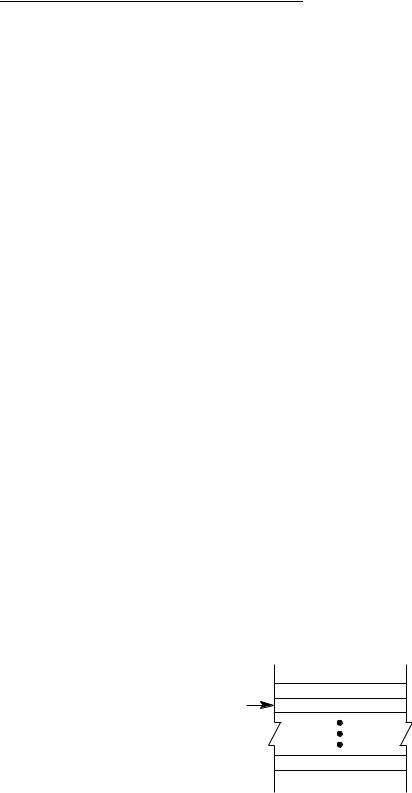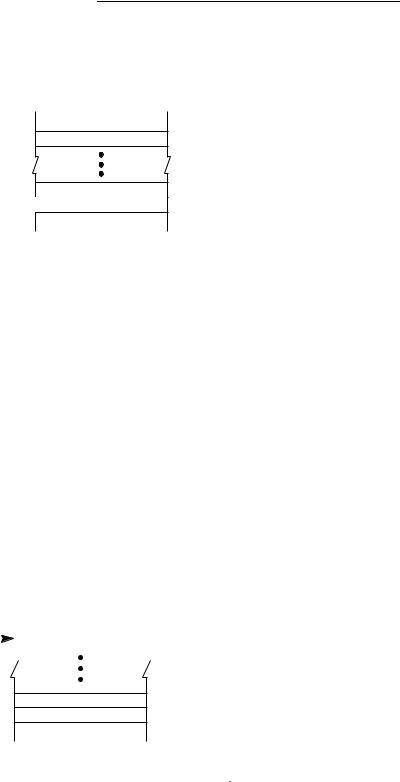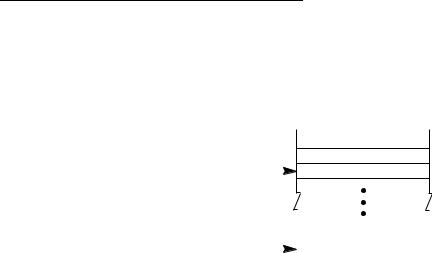
- •Table of Contents
- •List of Figures
- •List of Tables
- •1.1 Integer Unit User Programming Model
- •1.1.3 Program Counter
- •1.1.4 Condition Code Register
- •1.3 Supervisor Programming Model
- •1.3.2 Status Register
- •1.3.6 Transparent Translation/access Control Registers
- •1.4 Integer Data Formats
- •1.5 Floating-Point Data Formats
- •1.5.1 Packed Decimal Real Format
- •1.5.2 Binary Floating-Point Formats
- •1.6 Floating-Point Data Types
- •1.6.1 Normalized Numbers
- •1.6.2 Denormalized Numbers
- •1.6.3 Zeros
- •1.6.4 Infinities
- •1.6.5 Not-A-Numbers
- •1.6.6 Data Format and Type Summary
- •1.7 Organization of Data in Registers
- •1.7.1 Organization of Integer Data Formats in Registers
- •1.7.2 Organization of Integer Data Formats in Memory
- •1.7.4 Organization of Fpu Data Formats in Registers and Memory
- •2.1 Instruction Format
- •2.2 Effective Addressing Modes
- •2.2.1 Data Register Direct Mode
- •2.2.2 Address Register Direct Mode
- •2.2.3 Address Register Indirect Mode
- •2.2.4 Address Register Indirect with Postincrement Mode
- •2.2.5 Address Register Indirect with Predecrement Mode
- •2.2.6 Address Register Indirect with Displacement Mode
- •2.2.9 Memory Indirect Postindexed Mode
- •2.2.10 Memory Indirect Preindexed Mode
- •2.2.11 Program Counter Indirect with Displacement Mode
- •2.2.14 Program Counter Memory Indirect Postindexed Mode
- •2.2.15 Program Counter Memory Indirect Preindexed Mode
- •2.2.16 Absolute Short Addressing Mode
- •2.2.17 Absolute Long Addressing Mode
- •2.2.18 Immediate Data
- •2.3 Effective Addressing Mode Summary
- •2.4 Brief Extension Word Format Compatibility
- •2.5.1 No Memory Indirect Action Mode
- •2.5.2 Memory Indirect Modes
- •2.6.1 Other Data Structures
- •2.6.1 System Stack
- •2.6.2 Queues
- •3.1 Instruction Summary
- •3.1.1 Data Movement Instructions
- •3.1.2 Integer Arithmetic Instructions
- •3.1.3 Logical Instructions
- •3.1.4 Shift and Rotate Instructions
- •3.1.5 Bit Manipulation Instructions
- •3.1.6 Bit Field Instructions
- •3.1.7 Binary-Coded Decimal Instructions
- •3.1.8 Program Control Instructions
- •3.1.9 System Control Instructions
- •3.1.11 Multiprocessor Instructions
- •3.1.13 Floating-Point Arithmetic Instructions
- •3.2 Integer Unit Condition Code Computation
- •3.3 Instruction Examples
- •3.3.2 Using the Moves Instruction
- •3.3.3 Nested Subroutine Calls
- •3.3.4 Bit Field Instructions
- •3.3.5 Pipeline Synchronization with the Nop Instruction
- •3.4 Floating-Point Instruction Details
- •3.5 Floating-Point Computational Accuracy
- •3.5.1 Intermediate Result
- •3.5.2 Rounding the Result
- •3.6 Floating-Point Postprocessing
- •3.7 Instruction Descriptions
- •8.1 Instruction Format
- •8.1.1 Coprocessor ID Field
- •8.1.2 Effective Address Field
- •8.1.4 Source Specifier Field
- •8.1.5 Destination Register Field
- •8.1.6 Conditional Predicate Field
- •8.1.7 Shift and Rotate Instructions
- •8.1.8 Size Field
- •8.1.9 Opmode Field
- •8.1.10 Address/Data Field
- •8.2 Operation Code Map
- •A.1 MC68000, MC68008, MC68010 Processors
- •A.1.2 MC68000, MC68008, and MC68010 Addressing Modes
- •A.2 MC68020 Processors
- •A.2.1 MC68020 Instruction Set
- •A.2.2 MC68020 Addressing Modes
- •A.3 MC68030 Processors
- •A.3.1 MC68030 Instruction Set
- •A.3.2 MC68030 Addressing Modes
- •A.4 MC68040 Processors
- •A.4.1 MC68040 Instruction Set
- •A.4.2 MC68040 Addressing Modes
- •A.5 MC68881/MC68882 CoProcessors
- •A.5.2 MC68881/MC68882 Addressing Modes
- •A.6 MC68851 Coprocessors
- •A.6.1 MC68851 Instruction Set
- •A.6.2 MC68851 Addressing Modes
- •B.1 Exception Vector Assignments for the M68000 Family
- •B.2 Exception Stack Frames
- •B.3 Floating-Point Stack Frames
- •C.1 S-Record Content
- •C.2 S-Record Types
- •C.3 S-Record Creation

Addressing Capabilities
2.6 OTHER DATA STRUCTURES
Stacks and queues are common data structures. The M68000 family implements a system stack and instructions that support user stacks and queues.
2.6.1 System Stack
Address register seven (A7) is the system stack pointer. Either the user stack pointer (USP), the interrupt stack pointer (ISP), or the master stack pointer (MSP) is active at any one time.
Refer to Section 1 Introduction for details on these stack pointers. To keep data on the system stack aligned for maximum efficiency, the active stack pointer is automatically decremented or incremented by two for all byte-size operands moved to or from the stack.
In long-word-organized memory, aligning the stack pointer on a long-word address significantly increases the efficiency of stacking exception frames, subroutine calls and returns, and other stacking operations.
The user can implement stacks with the address register indirect with postincrement and predecrement addressing modes. With an address register the user can implement a stack that fills either from high memory to low memory or from low memory to high memory. Important consideration are:
•Use the predecrement mode to decrement the register before using its contents as the pointer to the stack.
•Use the postincrement mode to increment the register after using its contents as the pointer to the stack.
•Maintain the stack pointer correctly when byte, word, and long-word items mix in these stacks.
To implement stack growth from high memory to low memory, use -(An) to push data on the stack and (An) + to pull data from the stack. For this type of stack, after either a push or a pull operation, the address register points to the top item on the stack.
.
LOW MEMORY
(FREE)
An |
TOP OF STACK |
BOTTOM OF STACK
HIGH MEMORY
2-28 |
M68000 FAMILY PROGRAMMER’S REFERENCE MANUAL |
MOTOROLA |

Addressing Capabilities
To implement stack growth from low memory to high memory, use (An) + to push data on the stack and -(An) to pull data from the stack. After either a push or pull operation, the address register points to the next available space on the stack. .
LOW MEMORY
BOTTOM OF STACK
TOP OF STACK
An  (FREE)
(FREE)
HIGH MEMORY
2.6.2 Queues
The user can implement queues, groups of information waiting to be processed, with the address register indirect with postincrement or predecrement addressing modes. Using a pair of address registers, the user implements a queue that fills either from high memory to low memory or from low memory to high memory. Two registers are used because the queues get pushed from one end and pulled from the other. One address register contains the put pointer; the other register the get pointer. To implement growth of the queue from low memory to high memory, use the put address register to put data into the queue and the get address register to get data from the queue.
After a put operation, the put address register points to the next available space in the queue; the unchanged get address register points to the next item to be removed from the queue. After a get operation, the get address register points to the next item to be removed from the queue; the unchanged put address register points to the next available space in the queue. .
|
|
|
|
LOW MEMORY |
|
|
|
|
|
LAST GET (FREE) |
|
GET (Am) + |
|
|
|
NEXT GET |
|
|
|
||||
|
|
|
|
|
|
LAST PUT
PUT (An) +  (FREE)
(FREE)
HIGH MEMORY
To implement the queue as a circular buffer, the relevant address register should be checked and adjusted. If necessary, do this before performing the put or get operation. Subtracting the buffer length (in bytes) from the register adjusts the address register. To implement growth of the queue from high memory to low memory, use the put address register indirect to put data into the queue and get address register indirect to get data from the queue.
MOTOROLA |
M68000 FAMILY PROGRAMMER’S REFERENCE MANUAL |
2-29 |

Addressing Capabilities
After a put operation, the put address register points to the last item placed in the queue; the unchanged get address register points to the last item removed from the queue. After a get operation, the get address register points to the last item placed in the queue.
.
LOW MEMORY
(FREE)
PUT – (An) |
|
LAST PUT |
|
|
|
|
|
|
|
|
NEXT GET |
GET – (Am) |
|
|
LAST GET (FREE) |
|
|||
|
|
|
HIGH MEMORY |
|
|
|
|
To implement the queue as a circular buffer, the get or put operation should be performed
first. Then the relevant address register should be checked and adjusted, if necessary. Adding the buffer length (in bytes) to the address register contents adjusts the address register.
2-30 |
M68000 FAMILY PROGRAMMER’S REFERENCE MANUAL |
MOTOROLA |
